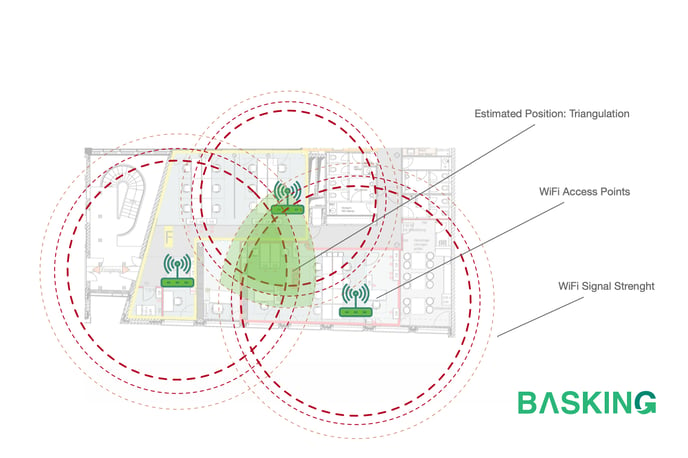Triangulation is a technology to estimate the position of a device within the office space. How does it work in detail?
This article applies to the following integrations:
- WiFi-Based integrations
Short Answer
Corporate WiFi networks, specifically the corporate WiFi management system, can use the position of APs (access points) to estimate the position of WiFi-enabled devices. This technique is called triangulation.
Triangulation works similarly in a way to GPS, but only within the scope of the office space and without the need to install any application or specific hardware on mobile phones. Similarly to GPS, triangulation based on WiFi has granularity limitations. In the case of WiFi, this is even higher than GPS.

Details
Corporate WiFi networks, specifically the corporate WiFi management system, can utilize the position of APs (access points) to accurately estimate the location of WiFi-enabled devices. This innovative technique, known as triangulation, allows businesses to track the whereabouts of these devices within the confines of their office space. The beauty of this method lies in its simplicity, as it does not require the installation of any additional hardware or software within the office space or mobile devices.
Operation
Triangulation operates in a similar fashion to the Global Positioning System (GPS), but with a more limited range. While GPS can determine location on a global scale, triangulation based on WiFi is confined to the specific area covered by the corporate WiFi network.
By leveraging the positions of various access points, the corporate WiFi management system can calculate the approximate location of WiFi-enabled devices. This is achieved by measuring the signal strengths and time delays of the WiFi signals received by the devices from the surrounding access points. These data points are then used to triangulate the device's position. The more access points available, the more accurate the estimation becomes.
Accuracy compared to GPS
It is important to note that WiFi-based triangulation has its limitations. The granularity of the estimated position is influenced by factors such as the density of access points, signal interference, and the presence of obstacles like walls or furniture. The more access points, the more access points are going to be "in range" and can contribute to the triangulation calculation. However, there is a natural limitation to this technology.
Generally, GPS is more accurate than the WiFi Triangulation. WiFi triangulation can be accurate up to 2-3 meters, which means that desk-level occupancy tracking is not possible with WiFi.
However, despite these limitations, WiFi-based triangulation remains a valuable tool for occupancy analytics in the office environment.
What can I expect?
In order to compensate for the granularity limitations of the WiFi triangulation, Basking provides occupancy numbers based on "Areas". Occupancy data within the areas is aggregated, thus providing accurate occupancy numbers at area level and compensating for the triangulation inaccuracy within.
